Intel's Pentium M on the Desktop - A Viable Alternative?
by Anand Lal Shimpi on February 7, 2005 4:00 PM EST- Posted in
- CPUs
Business/General Use Performance
Business Winstone 2004
Business Winstone 2004 tests the following applications in various usage scenarios:- Microsoft Access 2002
- Microsoft Excel 2002
- Microsoft FrontPage 2002
- Microsoft Outlook 2002
- Microsoft PowerPoint 2002
- Microsoft Project 2002
- Microsoft Word 2002
- Norton AntiVirus Professional Edition 2003
- WinZip 8.1
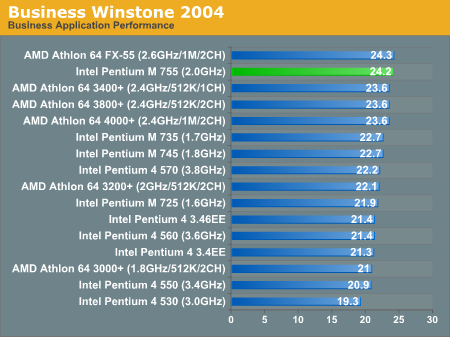
In business applications, the Pentium M does extremely well - with the 755 offering performance equivalent to that of an Athlon 64 FX-55. This is undoubtedly due to the extremely low latency L2 cache, which matters considerably in business applications.
Office Productivity SYSMark 2004
SYSMark's Office Productivity suite consists of three tests, the first of which is the Communication test. The Communication test consists of the following:"The user receives an email in Outlook 2002 that contains a collection of documents in a zip file. The user reviews his email and updates his calendar while VirusScan 7.0 scans the system. The corporate web site is viewed in Internet Explorer 6.0. Finally, Internet Explorer is used to look at samples of the web pages and documents created during the scenario."
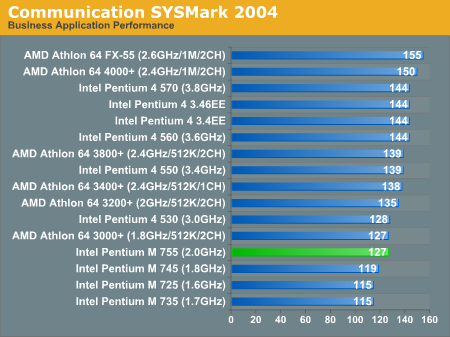
Immediately, we see that the Pentium M can't always do well, as even the 2.0GHz Pentium M 755 can't outperform the Athlon 64 3000+. The communication suite stresses memory bandwidth and latency rather than applications and usage patterns that fit into cache, so the Pentium M loses out big time.
The next test is Document Creation performance, which shows very little difference in drive performance between the contenders:
"The user edits the document using Word 2002. He transcribes an audio file into a document using Dragon NaturallySpeaking 6. Once the document has all the necessary pieces in place, the user changes it into a portable format for easy and secure distribution using Acrobat 5.0.5. The user creates a marketing presentation in PowerPoint 2002 and adds elements to a slide show template."
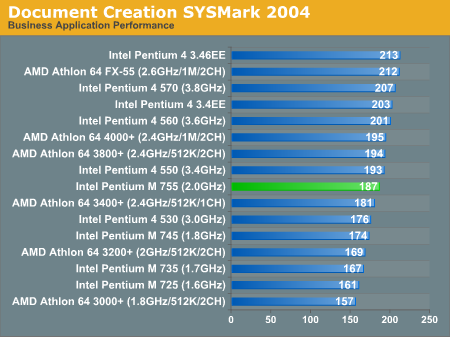
The Pentium M does a bit better in the document creation tests, as they are mostly using applications that will fit within the CPU's cache. However, the introduction of a voice recognition program into the test stresses the Pentium M's floating point performance, which does hamper its abilities here.
The final test in our Office Productivity suite is Data Analysis, which BAPCo describes as:
"The user opens a database using Access 2002 and runs some queries. A collection of documents are archived using WinZip 8.1. The queries' results are imported into a spreadsheet using Excel 2002 and are used to generate graphical charts."
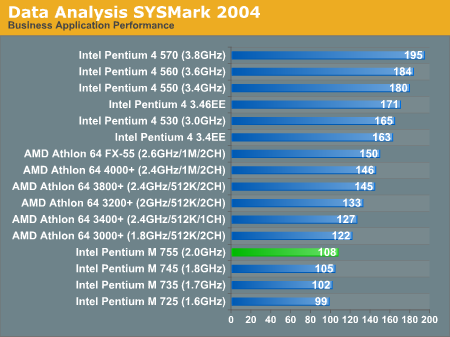
Without a doubt, the inclusion of Access usage patterns in the data analysis suite kills the Pentium M's chances here, as it once again brings up the tail in performance.
Microsoft Office XP SP-2
Here, we see in that the purest of office application tests, performance doesn't vary all too much.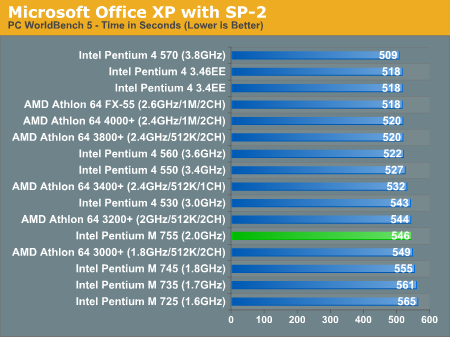
The Pentium M is competitive here, but so are all of the other CPUs.
Mozilla 1.4
Quite possibly the most frequently used application on any desktop is the one that we pay the least amount of attention when it comes to performance. While a bit older than the core that is now used in Firefox, performance in Mozilla is worth looking at as many users are switching from IE to a much more capable browser on the PC - Firefox.
The Pentium M does extremely well here, outperforming both Athlon 64 and Pentium 4 competitors. Only the higher clock speed of the Athlon 64 gives it the overall lead here.
ACD Systems ACDSee PowerPack 5.0
ACDSee is a popular image editing tool that is great for basic image editing options such as batch resizing, rotating, cropping and other such features that are too elementary to justify purchasing something as powerful as Photoshop. There are no extremely complex filters here, just pure batch image processing.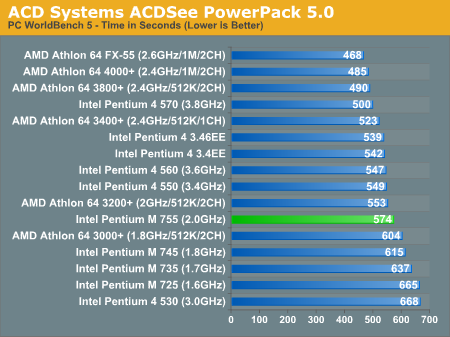
Once again, we see the Pentium M bring up the rear in situations where its low latency L2 cache can't help it.
Winzip

The Pentium M is fairly competitive in the real-world WinZip test - coming in third place overall, but the margin of victory isn't too great.
Let's look at how its peak theoretical performance is under WinRAR's built in benchmark:
WinRAR 3.40
Pulling the hard disk out of the equation, we can get a much better idea of which processors are truly best suited for file compression.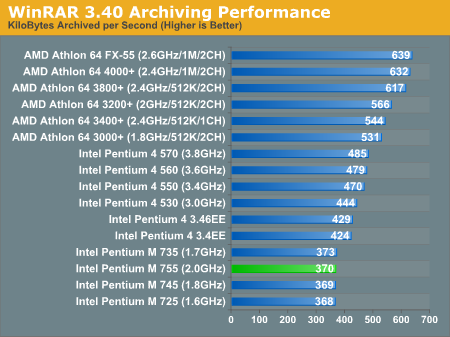
Here, we see that the lack of memory bandwidth really hurts the performance potential of the Pentium M. Luckily, most archiving tasks are usually disk-limited, so the performance differential won't be this bad in reality.










77 Comments
View All Comments
Jeff7181 - Monday, February 7, 2005 - link
Give the Dothan a speed bump and some dual channel DDR400 and stay out of it's way...MDme - Monday, February 7, 2005 - link
well, now we FINALLY have a comprehensive review of the P-M, it's strengths and weaknesses. While the P-M is good. the A64 is still better.Netopia - Monday, February 7, 2005 - link
Yeah, I was about to say the same as #3.Why did you go to the trouble to list what the AthlonXP system would have in it and then not actually test or reference it anywhere in the article?
I still have a bunch of AXP machines and regularly help others upgrade using XP-M's, so it would be interesting to see these at least included in reviews for a while.
CrystalBay - Monday, February 7, 2005 - link
Hi, I noticed in the testbed an AXP3200/NF2U400 but there are no charts with this setup.Beenthere - Monday, February 7, 2005 - link
It's a pipe dream for those who wish Intel had their act together. It's already confirmed M don't scale well and is not effective for HD computing. It's performance is really some place between Sempron and A64 but certainly not a suitable competitor to A64 nor FX. Just another Hail Mary for a defunct Intel.coldpower27 - Monday, February 7, 2005 - link
Hmm, an interesting review on the Pentium M to say the least. Though are 2-2-2-10 timings for the Pentium M the best for this architecture???0ldman79 - Wednesday, January 26, 2022 - link
It's interesting coming back and reading this after it's all settled, Core 2 seemed to be an evolution of the Pentium M line.Intel did hang the Netburst architecture up, though they added a lot of Netburst's integer design to Core 2 while designing Nehalem. AMD apparently believed that Intel was going to stick with Netburst and designed the FX line, while Intel went back to their earlier designs and lowered the clock speed, massively increased the IPC and parallelism and out-Phenom'ed the Phenom with Nehalem.
Back then Intel believed that Dennard scaling would continue and they'd have 10GHz chips, turns out wider and slower is better.